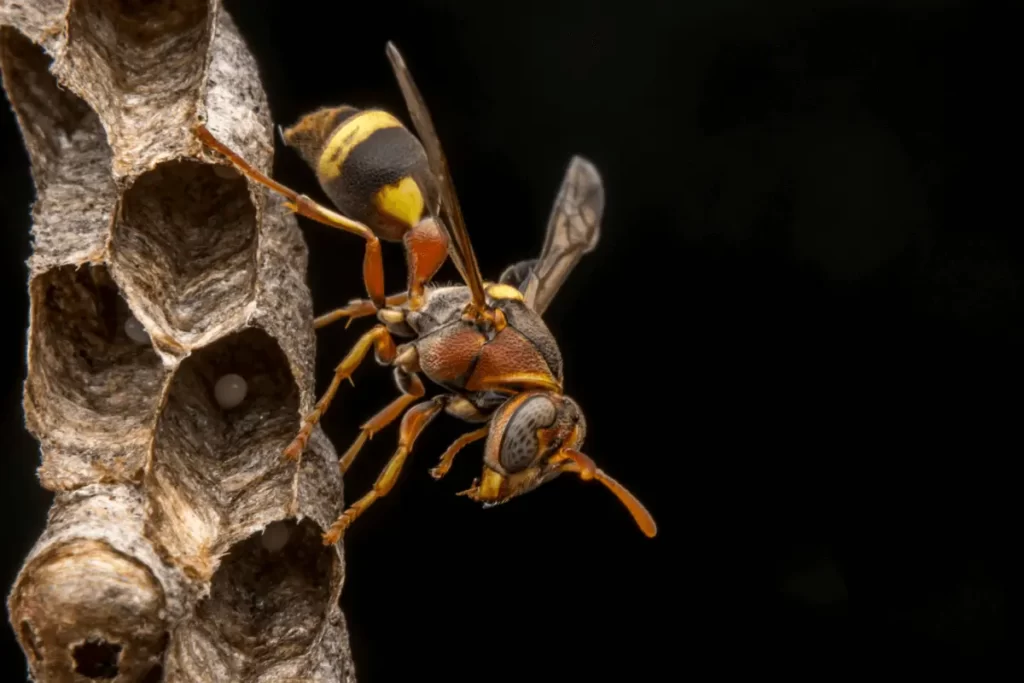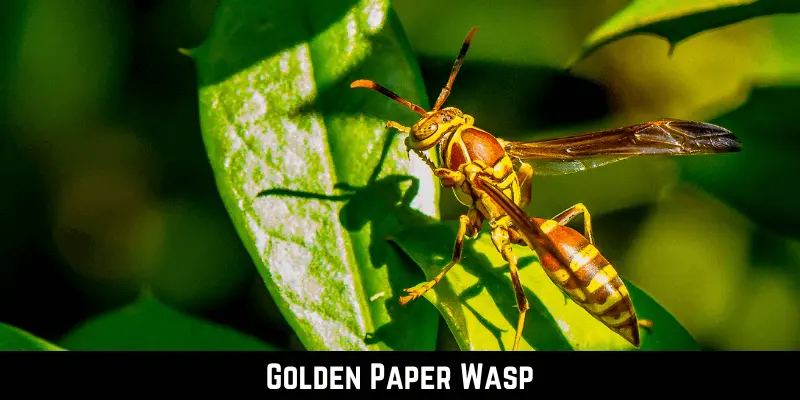Some are special in the big world of bugs because of how they look and act. One of these special bugs is the Golden Paper Wasp. So, what is the Golden Paper Wasp, and why do we care about it?
The Golden Paper Wasp, with the science name Polistes aurifer, is famous for its shiny gold color and its special paper homes. This wasp is important because it helps nature in many ways. We can learn many things about how it lives and helps other plants and animals.
If you want to know more about this pretty bug, keep reading. This article will tell you about the Golden Paper Wasp and why it’s so special.
The Distinct Appearance of the Golden Paper Wasp

Size and Color
The Golden Paper Wasp is a beautiful bug that shines brightly in the sun. It is about 15 to 20 millimeters long, so it’s not too small or too big. What makes it special is its gold color. Imagine an old gold coin or the color of honey, and that’s the color of this wasp. This bright color also warns other animals that it can defend itself. When the sun shines on it, it looks even more beautiful.
Wings and Antennae
Besides its color, the wasp’s wings and antennae are also special. The wings are thin and clear, like a fine piece of cloth. They move in a way that makes them look like they’re dancing with light and shadow. The antennae are very important for the wasp. They move around a lot, helping the wasp feel and understand its world. You can guess what the wasp might think or feel by watching how the antennae move.
Habitat and Distribution Of Golden Paper Wasp
Geographic Range
The Golden Paper Wasp is found in many places around the world, just like travelers who go on big adventures. They live in parts of North and Central America. You can find them in sunny places like the United States’ southwest and in Central America’s rainforests. This means they can live in different types of weather and places. This can live in both the deserts of Texas and the wet rainforests of Costa Rica. That’s pretty cool!
Preferred Habitats
Even though the Golden Paper Wasp travels a lot, they have special places they call home. They like to live in natural places like forests. But, they can also live near people, in cities and towns. Think of an old barn where farmers keep their animals.
There, in a quiet spot, you might find a wasp’s nest. Or, in a busy city garden, among the flowers, you might see this shiny gold bug flying around. It shows us that nature can be found everywhere, even where lots of people live.
Dietary Habits Of Golden Paper Wasp
What Do They Feed On?
- Nectar: Like we enjoy sweet drinks, these wasps love drinking nectar from flowers. It gives them a lot of energy.
- Caterpillars and Bugs: They also eat caterpillars and other small bugs. This shows that they eat both sweet and meaty things.
- Honeydew: Aphids make a sweet thing called honeydew. The Golden Paper Wasp loves eating this, too.
- Mud: Sometimes, you might see these wasps drinking from muddy puddles. They’re not just playing but also getting important minerals from the mud.
The Importance of Their Diet
When they drink nectar from flowers, they help the flowers make seeds. They move pollen from one flower to another. It’s teamwork: the flower gives the wasp food, and the wasp helps the flower make more flowers.
By eating caterpillars and bugs, they also help control the number of these bugs. This is good for plants and crops because too many bugs can be harmful. All the things they eat show how everything in nature is connected. Everything the wasp eats is important, from the sweet nectar to the mud. It reminds us that every small thing has a big role in nature, and we should care for our world.
The Life Cycle of the Golden Paper Wasp
- Starting as Eggs: Think of the first step in drawing a picture. That’s how the wasp’s life begins, with tiny eggs. The queen wasp lays these in their paper-like homes. Each egg is like a promise of a new wasp.
- Growing as Larvae: Baby wasps, called larvae, come out of these eggs. They’re soft and need a lot of care. Worker wasps bring them food so they can grow.
- Changing in Pupae: After a while, these baby wasps wrap themselves up, like in a little sleeping bag. Inside, they start changing. They’re getting ready to become adult wasps.
- Living as Adults: When ready, they appear as grown-up wasps, shining and beautiful. Some hunt for food, some protect their home, and some become queens to lay more eggs.
- Through the Year: The wasp’s life follows the seasons. In spring, they build new homes. In the fall, new queens and males get ready to mate. It’s mostly quiet in winter, with only the new queens waiting for spring to start.
The Unique Behavior of Golden Paper Wasps
Social Structure and Communication
Golden Paper Wasps live in groups, much like people live in towns with leaders and workers. The main wasp, called the queen, is like the leader. She has ways of telling the other wasps what to do, using smells and actions.
The other wasps, called worker wasps, do different jobs to help the group. They talk to each other by moving and touching. It’s like they have a special dance to say where to find food or if there’s danger. Their feelers, called antennae, help them understand each other. These wasps show that even small creatures can have smart ways to communicate.
Feeding Habits
Golden Paper Wasps eat different things and are smart about it. They don’t just find food; they also hunt. They catch bugs like caterpillars to feed their babies. But they also love sweet things. They visit flowers to drink nectar like we might enjoy a sweet drink. This is good for both the wasps and the flowers. While drinking nectar, they help flowers make seeds. By eating bugs, they help plants stay safe from pests.
The Significance Of Golden Paper Wasp in Ecosystem
Their Role in Pollination
Golden Paper Wasps do more than just look pretty. When they go from one flower to another to get nectar, they help flowers make seeds. How? Pollen from one flower sticks to the wasp and goes to the next flower they visit.
This helps flowers grow new plants. So, when you see a flower or eat a fruit, remember that these wasps made that happen. It’s like the wasp is helping flowers talk to each other.
Natural Predators and Their Balance in Nature
Nature is all about balance. While Golden Paper Wasps are good at catching small bugs to eat, bigger animals like birds and spiders try to eat them, too. This is nature’s way of making sure there aren’t too many wasps.
If a bird eats a wasp, it helps keep everything in check. Also, where you find these wasps, you might find other creatures like birds or spiders. They come hoping to find food. So, the wasp helps bring different animals together in one place.
Golden Paper Wasp Sting
Nature has given many creatures tools to help them survive. The Golden Paper Wasp’s sting is one such tool. It’s not just for hurting but has a special mix of chemicals from nature’s playbook. If someone gets too close to the wasp’s home, they might get stung. This sting is a strong way for the wasp to tell others to keep their distance.
The pain from a wasp’s sting isn’t just any pain. It has special substances that act under the skin, showing how protective the wasp is about its home. Some people say the sting feels like a short, sharp burn. It’s the wasp’s way of showing how deeply it cares about its family and home.
Are Golden Paper Wasps Dangerous?
Whether something is dangerous depends on how people see it. The Golden Paper Wasp, shiny and beautiful, might make some people nervous. But calling them harmful might only give part of the story.
These wasps can defend themselves with their stings that carry special chemicals. However, they’re not out to hurt others. Their main goal is to protect their homes and families. They only use their sting when they need to ask for space and respect.
It might hurt for a short while if most people get stung, but it isn’t a big medical problem. However, some people can have stronger reactions and need to see a doctor. So, whether they’re “dangerous” can depend on the situation.
Different Wasp Types Found in The USA
There are numerous species of wasps and all are not dangerous but some of them are beneficial for the ecosystem. You can find everything about these species here:
Conclusion
The Golden Paper Wasp is special in the big world of many creatures. It’s not just another bug with wings. These wasps do important jobs, like helping flowers grow by moving pollen. They also protect their homes and families. Their sting tells others to stay away, but they’re not out to hurt anyone on purpose. Sometimes, people might think they’re dangerous because they don’t understand them.
It’s our job to learn more about them. When we know about the Golden Paper Wasp, we see how they fit into nature and help keep things balanced. We can learn much from them about how everything in nature is connected. Let’s take the time to understand and appreciate their story.

